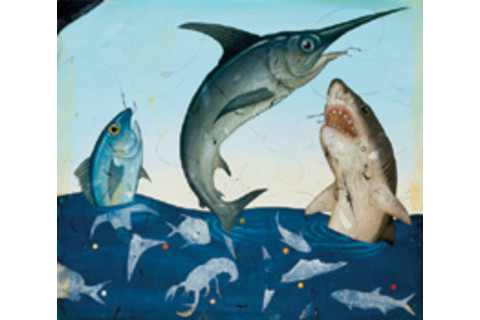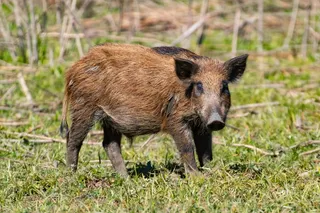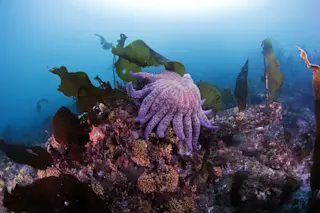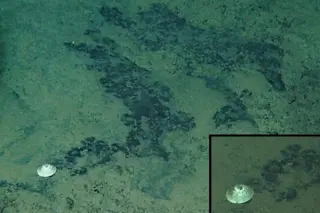The Great Apes Edge Toward Extinction
The finding was bad enough: During the last two decades, the population of wild chimpanzees and gorillas in the West African nations of Gabon and the Republic of the Congo has declined by more than half. But it was the context that made the news so discouraging. The dense forests in the two nations harbor an estimated 80 percent of the world’s remaining great apes, whose numbers have plunged elsewhere in Africa as human populations have expanded.
What’s more, scientists and conservationists have been active in the area for many years. “The fact that all of this could go on before our eyes and we didn’t see it happening is the really scary thing,” says Lee White, a Wildlife Conservation Society ecologist and coauthor of a study published in April that sounds a dire warning. Without aggressive intervention, wild chimps and gorillas could be pushed to the brink of extinction in just one decade.
Gabon and the Republic of the Congo were once thought to be safe havens for the great apes because the forest habitats in both countries remain largely intact. But a research team led by ecologist Peter Walsh of Princeton University discovered that conservation efforts are no match for two stealth threats: hunting and the Ebola virus.
Logging has been limited to selective thinning of forestland, but the roads built to accommodate mechanized equipment have provided organized groups of hunters with easier access to the apes and helped support a growing and illegal trade in “bush meat.” Meanwhile, Ebola outbreaks are decimating gorillas in the remote regions where their density is greatest. Researchers believe that sporadic Ebola outbreaks in Gabon have killed thousands of gorillas—perhaps as many as 9,000 between 1992 and 2000.
No one knows if more outbreaks are occurring now than in the past or if more gorillas are dying during each outbreak. At present, the hot zone is in the northwest Republic of the Congo, where White says Ebola is advancing “like a weather front” on the border of Odzala National Park, a 3,475-square-mile wildlife preserve that is home to about 50,000 gorillas.
The research team called for the status of wild chimps and gorillas to be raised to “critically endangered” and for foreign governments to link aid to verifiable efforts to stop hunting and the traffic in bush meat. White is also hopeful that a new Ebola vaccine developed under the auspices of the National Institutes of Health (see “Fast-Acting Ebola Vaccine Tested,” page 61) will prove useful in containing outbreaks among gorillas.
—Eric Levin
Bizarre Bacterium Dines on Toxic Waste
The soil behind the abandoned dry cleaners in Oscoda, Michigan, was saturated with chlorinated solvents that had been routinely dumped there for decades. The poisons had penetrated the water table and spread to Lake Huron, 150 yards away. When environmental engineer Frank Löffler visited the site, he discovered that microbes 20 feet underground appeared to be feasting on the toxic waste.
So he took some soil samples back to the lab and spent the next seven years studying the bizarre creatures from the deep. Finally, in July, Löffler announced that he and his colleagues at the Georgia Institute of Technology had isolated a previously unidentified bacterium—BAV1—that thrives on vinyl chloride, a carcinogen produced when the solvents in dry-cleaning fluids and metal cleaners break down.
Löffler also reported that he had unleashed the bacterium in a test pit at the Oscoda site and “it completely cleaned the site of contaminants in just six weeks.” With vinyl chloride present in one-third of the toxic waste sites the Environmental Protection Agency lists as high priorities for cleanup, BAV1 will be well fed for years to come.
—Michael W. Robbins
Deadly Extremes: The Weather Outside Was Frightful
Too hot, too cold, too wet, too windy, too dry. The weather in 2003 was often just too much. Kenneth Davidson of the World Meteorological Organization says the year may set a record for meteorological records. In late spring, the whole planet sweltered: Average land temperature for May was the highest in recorded history.
June was the hottest in at least 250 years in Switzerland, and southern France topped 104 degrees Fahrenheit—some 10 degrees above average. Indeed, the heat wave in France—a country that often gets by without air-conditioning—didn’t abate until the end of August, by which time more than 20,000 people had died. Meanwhile, heat waves in India were pushing the mercury to as much as 120°F, claiming at least 1,400 lives.
Bad weather battered as well as baked. In May a tropical cyclone drenched an already wet Sri Lanka, causing floods and landslides that killed 300. Also in May the United States was whipped by 562 tornadoes—topping the previous single-month record, set in June 1992, by more than 40 percent. In the American South, farmers reeled from one extreme to the other.
“After two years of drought and tremendous loss of crops, this year they’re losing crops because it’s too wet,” says Davidson. And in the Southern Hemisphere, a cold front of historic proportions hit South Africa on August 21 when the mercury in some areas sank as low as 13°F.
Affixing blame is nearly impossible with something as complex and capricious as the weather. Still, Davidson says, “Man’s influence is clear: We’ve increased the amount of greenhouse gases in the atmosphere, and that’s exacerbating the warming trend we’re already in.”
—Michael Abrams
Global Warming Triggers Genetic Change in Red Squirrels
Scientists have studied evolutionary changes since Charles Darwin set sail on HMS Beagle. But rarely have they watched one take place before their eyes. In March a team of biologists led by Stan Boutin of the University of Alberta reported a shift in the gene pool of North American red squirrels, one that can be placed squarely at the door of higher temperatures.
In the Kluane Lake region of Canada’s Yukon Territory, the team discovered that more and more female squirrels, who are able to breed only one day during the year, were mating, on average, 18 days earlier than they were a decade ago. It seems higher temperatures in the region, up 3.6 degrees Fahrenheit in the last 25 years, means spruce trees produce more cones—the squirrel’s main food—throughout the summer.
As a result, the squirrels stash more food for the winter. Come spring, they have more energy to reproduce, Boutin says. The shift, he adds, is increasingly dramatic. With each new generation, there are fewer who wait to breed.
The team made its discovery after tagging more than 5,000 squirrels and watching their movements for 10 years. They borrowed an analytical technique used in agricultural breeding (but never before applied to the study of wild populations) to determine that squirrel babies born earlier in the spring thrive and reproduce at a higher rate than squirrels born later.
Now Boutin and his colleagues have begun a three-to-five-year experiment in which they will further enhance the food supply of a group of squirrels “to see whether the timing of reproduction continues to advance.”
—Michael W. Robbins

Jason Holley
Extent of Great Whale Slaughter Worse Than Previously Thought
Scientists have greatly underestimated the historical carnage caused by commercial whaling, according to a study published in July. Using genetic techniques for the first time to estimate past populations, Stephen Palumbi of Stanford University and Joe Roman of Harvard University concluded that the oceans were once filled with 10 times more great whales than historical records indicate.
The new estimates suggest that proposals to lift the International Whaling Commission’s 18-year-old moratorium on commercial whaling are based on a faulty assessment of what constitutes natural population sizes.
The International Whaling Commission calculates natural population sizes based on analysis of the logbooks of whaling captains and other historical data. These sources suggest that, before widespread commercial exploitation began in the 19th century, the North Atlantic was home to 20,000 humpback whales.
Palumbi and Roman say the number should be 240,000. Likewise, Palumbi and Roman say that in the prewhaling era there were 360,000 fin whales, instead of the previous estimate of 30,000 to 50,000, and 265,000 minke whales, compared with the 100,000 historical records indicate is a natural population size.
Palumbi and Roman base their figures on analysis of mitochondrial DNA in blood samples taken from more than 312 humpbacks, 370 fin whales, and 87 minke whales, mostly in the North Atlantic. Their method takes many factors into account—including the fact that mitochondrial DNA is passed on only through eggs, not sperm—but the basic principle is that the greater the current genetic diversity within a species, the larger the population was in the distant past.
Some critics questioned the mutation rate the authors applied, and others noted that the sharp decline could have occurred eons ago—a point Roman and Palumbi don’t dispute. Yet the figures and formulas they applied were all very conservative, and the discrepancy between their historical estimates and the prevailing ones is huge.
Palumbi says the data can help guide conservation efforts. Recent estimates indicate there are now roughly 10,000 humpbacks, 56,000 fin whales, and 149,000 minke whales in the North Atlantic. “In light of our finding, current populations of humpback or fin whales are far from harvestable,” he says.
Another implication is that, since overhunting is largely the culprit, the North Atlantic can support many more whales than it does now. Palumbi says the ocean is being overrun by one-celled plants and microscopic animals—the very morsels whales eat.
—Jeffrey Winters
Ocean Fish Populations Plummet
There aren’t many fish in the sea. Last May biologists at Dalhousie University in Halifax, Nova Scotia, reported that global stocks of large predatory fish have declined by 90 percent since industrial fishing began in the mid-1950s. Not surprisingly, some of the greatest losses have come from species people eat: swordfish, tuna, cod, and shark.
Among the sources Dalhousie biologists Ransom Myers and Boris Worm looked at were the records of Japanese boats that use fishing lines up to 60 miles long, with 2,000 or more baited hooks, to catch anything that will bite. In a matter of 15 years, catches per hundred hooks dropped from around 10 to one. The boats were catching fish faster than the fish could reproduce.
A good deal of industrial fishing occurs in international waters, where fleets compete with little oversight or regulation. Commercial fishers have long resisted quotas and moratoriums that would allow fish populations to rebound, and governments have not done much about it. One large study of America’s ocean waters, published in May by the Pew Oceans Commission, noted that U.S. policies have for decades focused on developing ocean resources rather than emphasizing conservation.
Are tuna, swordfish, and shark headed for extinction as a result? “Mostly not,” Myers says. “Though I view the shark declines as very serious.” Sharks are slow to reproduce, so they may disappear in areas such as the North Atlantic. In some cases, when overfishing has been slowed or stopped, species such as striped bass have rebounded.
But no one really knows what happens when the top predators disappear from a large ecosystem—or what other fish are lost along the way. “We’ve been overexploiting the ocean everywhere we can get to,” Myers says, “even in places where we don’t yet know all of the species that exist.”
—Michael W. Robbins
China’s Three Gorges Dam Yokes the Unruly Yangtze
China’s notorious Yangtze River is finally coming under control. The Three Gorges Dam, the world’s largest hydroelectric project, sealed off the river in June, creating a lake that will eventually stretch for 375 miles and generate 85 billion kilowatt hours of pollution-free electricity a year. Clean power, already flowing, should be a godsend to a nation that still generates most of its electricity by burning coal. Below the dam, there will be serious flood control, no small achievement for a river that spills its banks once a decade, killing thousands as it did in 1998. Now major flooding is expected no more than once a century.
Time to uncork the champagne, or at least a bottle of plum wine, right? Not necessarily. By the time the dam is fully operational in 2009, about 1.2 million Chinese will have been displaced from their homes as the rising water engulfs entire towns. The Three Gorges—China’s equivalent in scenic drama to the Grand Canyon—will be largely buried underwater. Environmentalists inside and outside China warn that the rapidly expanding dam lake is already causing destructive soil erosion and has polluted the river with vast amounts of trapped sewage, agricultural chemicals, and hazardous industrial wastes. Salvage archaeologists have so far moved more than 300 historic buildings to higher ground. But that leaves about 1,200 archaeological treasure troves in imminent danger of being submerged, including Paleolithic and Neolithic sites that will never be investigated.
—Michael W. Robbins

Invesco Field (center), the new home of the Denver Broncos, stands cheek by jowl with the old Mile High Stadium in a 2001 IKONOS satellite image. Urban land use creates a heat-island effect because asphalt, brick, and concrete absorb and conduct solar energy, while the cooling effect of evaporation from soil and vegetation is reduced. | Space Imaging
Land Development Eyed as a Cause of Global Warming
Land-use changes in the United States, such as the conversion of undeveloped land to housing or agricultural use, appear to be contributing to global warming trends to a much greater degree than scientists previously thought. In a study published in May, meteorologists Eugenia Kalnay and Ming Cai of the University of Maryland reported that current land-use practices are altering the climate in a manner similar to that of the emission of greenhouse gases from factories and automobiles.
Previously, warming from land-use changes had been inferred from various measures of urbanization, including population counts and satellite measures of light at night. Kalnay and Cai developed a more precise measurement by comparing one set of long-term temperature data recorded from satellite and weather balloons, which detect the effects of warming from greenhouse gases, with another set recorded at ground level by 1,982 weather stations across the continent.
This comparative analysis of the atmospheric and ground-level temperature readings allowed Kalnay and Cai to isolate the warming effects of agricultural land-use changes and urban sprawl. They estimated that land-use changes in the continental United States since the 1960s have resulted in a rise in the mean surface temperature of 0.25 degree Fahrenheit, a figure Kalnay says “is at least twice as high as previous estimates based on urbanization alone.”
—Michael W. Robbins
Coral Killer Hitches a Ride in a Fireworm
For 20 years now, coral around the world has been turning ghostly white and dying, a condition known as bleaching. The coral loses the algae that live symbiotically inside and, consequently, its ability to photosynthesize. Scientists know that an obscure bacterium, Vibrio shiloi, is one cause. What they didn’t know—until now—is how the bacterium spreads.
V. shiloi is particularly active in Mediterranean waters—but only in summer when the water is warm. This year a team of microbiologists at Tel Aviv University discovered where the bacterium winters, which in turn led to an understanding of how it moves around. The culprit: a fireworm, a foot-long bristle worm that feeds on corals. “When we looked for the bacteria in the fireworm, we hit the jackpot,” says microbiologist Eugene Rosenberg.
The insides of a fireworm turn out to be a reasonably pleasant place for V. shiloi to camp out until external conditions turn favorable. The team introduced the germ-carrying worms into aquariums containing living corals. The pathogen caused total bleaching in just 17 days.
“It is likely that the fireworm picks up the bacterium in the summer by feeding on the coral and delivers it the next spring, when it again begins to feed on the coral,” Rosenberg says. The next step: figuring out how to control the wide-ranging fireworm.
—Michael W. Robbins
Condors Die, Condors Fly
As usual, this has not been a great year for endangered California condors. In February a hunter shot and killed a female condor that had been in the U.S. Fish and Wildlife Service’s captive breeding program since 1980; the hunter was fined $20,000 and given a five-year probation. In July a young condor recently released into the wild in California was killed, presumably by a coyote. “The young ones, in their first year or so, are most vulnerable,” says Fish and Wildlife Service biologist Mike Stockton. “They have a lot to learn about life in the wild.”
The good news: In Arizona last spring a nesting pair of California condors in Grand Canyon National Park produced a healthy condor chick in their cliffside nest in a remote area known as the Salt Creek drainage. It is the first California condor to hatch in the wild in Arizona in many decades and the first to hatch since the recovery program began placing condors in Arizona in 1996. There are about 40 freed condors in Grand Canyon National Park.
—Michael W. Robbins
Global Warming Disrupts Life Near the Equator
The effects of global warming are not limited to regions with cold or temperate climates. A study published in June reveals that long-term warming trends are triggering potentially devastating environmental changes close to the equator. Lake Tanganyika, in central Africa, is 410 miles long and a mile deep, holds one-sixth of the planet’s freshwater, and is a vital source of food for people in four bordering countries: Burundi, Tanzania, Zambia, and the Democratic Republic of the Congo.
Compared with a century ago, the lake’s temperature is up and its biomass down. “It’s in the tropics, so people think, ‘It’s warm anyway; global warming won’t matter,’” says Piet Verburg, a marine biologist at the University of Waterloo in Ontario. “This is not the case.”
Verburg measured temperatures at various depths and compared them with an extensive set of readings made between 1913 and 1975. He found that in the northern part of the lake temperatures at 328 feet have risen 1.6 degrees Fahrenheit. The extra heat seems to have disrupted the churning that brings nutrients from below to the surface.
Increased contrast between surface and bottom temperatures tends to segregate the water layers and keep them static, so the monsoon winds don’t mix the waters as much as they once did. In 1913 phytoplankton flourished near the surface of the lake, and sunlight penetrated no deeper than 56 feet.
Verburg determined that the layer of phytoplankton has become so transparent that light reaches a depth of 138 feet. Meanwhile, reduced oxygen circulation has forced one species of snail, Tiphobia horei, which lived as deep as 984 feet a century ago, to move to depths of 328 feet or less. And anecdotal evidence suggests that the sardine catch by local fishermen is down dramatically.
But the lives of phytoplankton, snails, and sardines in Lake Tanganyika are not irrevocably ruined. If the warming stops, temperatures will even out, the churn will resume, and “the lake can easily go back to its old state,” Verburg says.
—Michael Abrams
Revival Project Launched in Desiccated Aral Sea
Once upon a time the Aral Sea was the world’s fourth largest inland body of water. The massive central Asian saltwater lake was as large as West Virginia, with more water than Lake Erie and Lake Huron combined. But that was four decades ago, before the Soviet Union diverted the flow of two large feeder rivers to irrigate a desert for cotton and rice farming. It was a misbegotten move, creating one of the world’s worst environmental dead zones. Over time, the Aral shrank to a quarter of its original size and split into two separate lakes. The increased salinity of the remaining waters killed off a once abundant supply of sturgeon and carp and contaminated the groundwater. Sandstorms and wind-driven salt frequently roar across the barren sea, and the local populace has been plagued by tuberculosis, cancer, and one of the highest rates of infant mortality in the world.
Now things are beginning to change. In July the World Bank and the government of Kazakhstan launched an $86 million project to revive the Aral. Contractors began building an eight-mile earthen dike to channel water from the Syr Dar’ya River to the northern section of the Aral. In four years engineers expect the water level will rise to 13 feet, and more than 200 square miles of what is now bare seabed will be underwater once again. Several fish hatcheries that had shut down will be restocked, and fishing boats that had long been stranded on dry land may be pressed into service again.
—Michael W. Robbins














